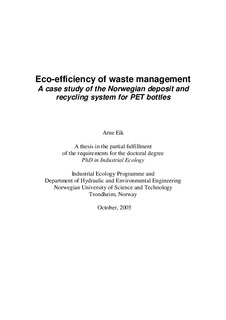| dc.contributor.advisor | Brattebø, Helge | nb_NO |
| dc.contributor.author | Eik, Arne | nb_NO |
| dc.date.accessioned | 2014-12-19T11:24:59Z | |
| dc.date.available | 2014-12-19T11:24:59Z | |
| dc.date.created | 2006-01-17 | nb_NO |
| dc.date.issued | 2005 | nb_NO |
| dc.identifier | 125804 | nb_NO |
| dc.identifier.isbn | 82-471-7301-8 | nb_NO |
| dc.identifier.uri | http://hdl.handle.net/11250/231280 | |
| dc.description.abstract | The Norwegian system for depositing and recycling of PET bottles (Resirk/PET system)started in May 2000, and is based on Norsk Resirk's mission of improving cost- and environmental efficiency of this system. Has this been achieved? What can explain the changes that occurred in the system during recent years? I have found that the eco-efficiency of the Resirk/PET system increased considerably every year between 2000 and 2003. The net greenhouse gas (GHG emission was improved from -562 kg CO2e (562 kg CO2 equivalents avoided generated) for waste management of one tonne consumed bottles in 2000 to -1442 kg CO2e per tonne in 2003, while the net cost was reduced from 4062 €/tonne in 2000 to 2683 €/tonne in 2003. This eco-efficiency improvement was very much driven by the increased volume and return rate of PET bottles during this period. The environmental performance of the Resirk/PET system was high compared to other waste management systems for PET bottles, while the economical performance was considerably lower. The interactive development of the bottled non-carbonated mineral water Imsdal contributed significantly to the increase of the Resirk/PET system’s volume and return rate and hence the system’s improved eco-efficiency. A white spirit sabotage on Imsdal in August 2002 contributed to the development of Imsdal as well as the Resirk/PET system’s change of the design and material specification for participating PET bottles. By combining the quantitative eco efficiency framework with the qualitative framework of interactive resourced development, information about how much eco-efficiency of a defined system has changed, as well as an understanding of reasons for changes within the system, has been acquired. Such a combination should be possible to apply for analysis of other systems as well, and may be a valuable contribution to the field of industrial ecology since the methods complement each other in a fruitful way. The eco-efficiency of the Resirk/PET system can be improved further by:
- Regarding used PET bottles as a resource to be applied for production
- Reducing packaging tax for PET bottles
- Increasing the bottle deposit
- Keeping the PET specification updated
- Improving collection efficiency
- Improving cost efficiency of marketing and information
- Increasing compaction and filling degree of reverse vending machines
- Considering automatic sorting
- Keeping focus on producing high quality PET flakes.
In addition to having showed that the approaches of eco-efficiency and interactive resource development can be combined, this thesis may have implications on how ecoefficiency can be quantified in waste management systems, and how the concepts of adaptation and friction in resource structures are dealt with. | nb_NO |
| dc.language | eng | nb_NO |
| dc.publisher | Fakultet for ingeniørvitenskap og teknologi | nb_NO |
| dc.relation.ispartofseries | Doktoravhandlinger ved NTNU, 1503-8181; 2005:202 | nb_NO |
| dc.subject | industrial ecology | en_GB |
| dc.subject | eco-efficeincy | en_GB |
| dc.subject | industrial network theory | en_GB |
| dc.subject | resources | en_GB |
| dc.subject | interactive resource development | en_GB |
| dc.subject | waste | en_GB |
| dc.subject | recycling | en_GB |
| dc.subject | PET | en_GB |
| dc.subject | Norsk Resirk | en_GB |
| dc.subject | TECHNOLOGY: Other technology: Environmental engineering | en_GB |
| dc.title | Eco-efficiency of waste management: A case study of the Norwegian deposit and recycling system for PET bottles | nb_NO |
| dc.type | Doctoral thesis | nb_NO |
| dc.source.pagenumber | 148 | nb_NO |
| dc.contributor.department | Norges teknisk-naturvitenskapelige universitet, Fakultet for ingeniørvitenskap og teknologi | nb_NO |
| dc.description.degree | PhD i industriell økologi | nb_NO |
| dc.description.degree | PhD in Industrial Ecology | en_GB |
